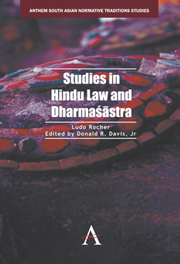Book contents
- Frontmatter
- Contents
- Foreword by Richard W. Lariviere
- Preface
- Abbreviations
- Note on the Edition
- Introduction
- PART ONE THE NATURE OF HINDU LAW
- PART TWO GENERAL TOPICS OF HINDU LAW
- PART THREE HINDU LEGAL PROCEDURE
- PART FOUR TECHNICAL STUDIES OF HINDU LAW
- Possession Held for Three Generations by Persons Related to the Owner
- The Vīramitrodaya on the Right of Private Defence
- The Technical Term Anubandha in Sanskrit Legal Literature
- The Kāmasūtra: Vātsyāyana's Attitude toward Dharma and Dharmaśāstra
- In Defense of Jīmūtavāhana
- Dāsadāsī
- The Definition of Vākparuṣya
- Janmasvatvavāda and Uparamasvatvavāda: The First Chapters on Inheritance in the Mitākṣarā and Dāyabhāga
- Karma and Rebirth in the Dharmaśāstras
- Notes on the Technical Term Sāhasa: “Fine, Pecuniary Penalty”
- Avyāvahārika Debts and Kautilya 3.1.1–11
- The Sūtras and Śāstras on the Eight Types of Marriage
- Caritraṃ Pustakaraṇe
- The Terms Niyukta, Aniyukta, and Niyoga in Sanskrit Legal Literature
- The Aurasa Son
- The Introduction of the Gautamadharmasūtra
- PART FIVE ANGLO-HINDU AND CUSTOMARY LAW
- Bibliography
- Index
The Aurasa Son
from PART FOUR - TECHNICAL STUDIES OF HINDU LAW
Published online by Cambridge University Press: 05 February 2013
- Frontmatter
- Contents
- Foreword by Richard W. Lariviere
- Preface
- Abbreviations
- Note on the Edition
- Introduction
- PART ONE THE NATURE OF HINDU LAW
- PART TWO GENERAL TOPICS OF HINDU LAW
- PART THREE HINDU LEGAL PROCEDURE
- PART FOUR TECHNICAL STUDIES OF HINDU LAW
- Possession Held for Three Generations by Persons Related to the Owner
- The Vīramitrodaya on the Right of Private Defence
- The Technical Term Anubandha in Sanskrit Legal Literature
- The Kāmasūtra: Vātsyāyana's Attitude toward Dharma and Dharmaśāstra
- In Defense of Jīmūtavāhana
- Dāsadāsī
- The Definition of Vākparuṣya
- Janmasvatvavāda and Uparamasvatvavāda: The First Chapters on Inheritance in the Mitākṣarā and Dāyabhāga
- Karma and Rebirth in the Dharmaśāstras
- Notes on the Technical Term Sāhasa: “Fine, Pecuniary Penalty”
- Avyāvahārika Debts and Kautilya 3.1.1–11
- The Sūtras and Śāstras on the Eight Types of Marriage
- Caritraṃ Pustakaraṇe
- The Terms Niyukta, Aniyukta, and Niyoga in Sanskrit Legal Literature
- The Aurasa Son
- The Introduction of the Gautamadharmasūtra
- PART FIVE ANGLO-HINDU AND CUSTOMARY LAW
- Bibliography
- Index
Summary
“In modern times the courts generally recognize only two kinds of sons, namely aurasa and dattaka, the other kinds of sons being held to be obsolete.” In fact, the claim that most of the various kinds of sons recognized by the ancient ṛṣis had become obsolete is not restricted to “modern times.” It goes back far into the past. According to a verse attributed to Bṛhaspati, “presentday” people were no longer able to distinguish between the different kinds of sons introduced by the Seers:
anekadhā kṛtāḥ putrā ṛṣibhiś ca putrātmanaiḥ;
na śakyante ‘dhunā kartuṃ śaktahīnair idantanaiḥ. (26.29)
Yet the Dharmaśāstras —including Bṛhaspati's—, the commentators, and the modern treatises on Hindu law prior to 1955/56 went on to list and, in many cases, define and discuss 12 different kinds of sons.
Even though the lists of 12 kinds of sons differ in detail (for comparative lists, see Kane 1930–1962: 3.645; Mayne 1950: 107), there are some features which most of them share:
The different kinds of sons are always listed in descending order of importance. Says Nārada:
pūrvaḥ pūrvaḥ smṛtaḥ śreṣṭho jaghanyo yo ya uttaraḥ. (13.47cd/45cd)
And so does Viṣṇu:
eteṣāṃ pūrvaḥ pūrvaḥ śreyān. (15.28)
Whereas all other sons appear at different places in the several lists, the aurasa son invariably occupies the first place. Some texts underscore this position explicitly. Vasiṣṭha's definition (17.13; see below) does not include the term aurasa, but is followed by prathamaḥ. Viṣṇu's definition (15.2; see below) ends: aurasaḥ prathamaḥ.
- Type
- Chapter
- Information
- Studies in Hindu Law and Dharmasastra , pp. 613 - 622Publisher: Anthem PressPrint publication year: 2012
- 1
- Cited by



